EBR charges a service fee to manufacturers to produce ebike reviews and videos, this began in 2018. It’s the same flat fee for each bike, and it helps us to keep the site going while limiting ad clutter. We appreciate the opportunity to serve you with our opinions and data but respect your right to know that we receive compensation :)
The Amego Elevate is a hardtail electric mountain bike, designed for light trail and cross country use… or urban transport! They sell mudguards and a rear rack with backlight if you plan on commuting occasionally. It’s a product that only comes in one size, to keep the price down, but there are two color options and they both look great. Both Space Grey and Silver can be unisex, and they increase side visibility at night and other low-lighting conditions. Most of the accessories, bike hardware, and drive systems are black. I especially like the black rims and suspension fork, which offers lockout and preload adjust. It’s a spring fork, which isn’t quite as adjustable or lightweight as an air fork, but it offers a good 100 mm travel to soak up potholes, stumps, and rock obstacles. A few areas of the bike have been upgraded with name-brand parts and those include the Schwalbe Smart Sam tires, Shimano Alivio 24-speed drivetrain, Tektro hydraulic disc brakes, and Das-Kit motor system. For just under $2k, you get a platform that is versatile, faster than average (with a top speed of ~25 mph), and available through a handful of shops or online with free shipping. Amego is a Canadian company that has been designing and selling ebike products since 2010. I was able to speak with the founder, Virginia Block, for this review, and she explained that they check every bike before shipping out.
Driving the Elevate is a 500 watt nominally rated internally geared hub motor. It’s quieter than some of the Bafang products that I have tested, and it’s fairly compact given the high power output. Virginia explained that it can deliver up to 80 Newton meters of torque, which is quite high, but it cannot leverage gears the way that a mid-drive could. The upside is that the motor always feels zippy, it doesn’t matter which of the 24 gear combinations you are pedaling with. And, the motor can deliver instant power with the trigger throttle. Hub motors are a great fit for hardtail mount bikes because there is no rear suspension to interfere with. As you shift gears, there won’t be increased mashing or forces applied to the drivetrain because the motor operates completely independently of the chain and sprockets. You could lose the chain, and the motor would still operate and keep the bike going with pedal assist (because it uses a cadence sensor), or the throttle. Of course, this motor will use more power if you’re constantly starting with the throttle, but that’s a worthwhile trade for someone like myself, who has a knee injury. I love being able to override assist with the throttle at any time. Technically, this ebike is a Class 3 product because it assists up to ~25 mph. You could turn down the top speed by entering the display settings (hold the + and – button simultaneously) to make to make it Class 2 (20 mph assist and including throttle operation) or you could completely remove the throttle to make it Class 1 (20 mph assist only) for use on mountain bike trails. There’s a lot of choice here and I just want to close this focus on the motor by saying that the controller sends a lot of energy to the motor, providing a zippier than average feel.
Powering the Amego Elevate is a high capacity Lithium-ion battery pack, offering 48 volts and 13 amp hours of capacity! I’d call 500 watt hours average for the 2018 season, but this pack offers 624 watt hours, and that means you can go further or ride at higher speeds. Note that whenever you’re operating around or above 20 mph, air resistance is going to cause exponential energy draw and range will be decreased. This pack delivers electricity to the motor, but also the backlit display panel (hold the + icon to turn on backlighting), and even a full sized USB charging port on the top right side. You could use this port to maintain phones, GPS, or music devices as you ride or when parked at home or a camp site. My friends recently took a bikepacking trip using another electric bike, and this sort of charging-on-the-go feature would be really handy. If you’re excited to charge while riding, I recommend using a right-angle USB adapter like this, just to keep the wires tucked in and out of the way while you pedal. The battery pack weighs more than average at ~9.2 lbs, but the alloy casing is sturdy and most of the weight is kept low and center on the bike frame. I took the pack off when moving the bike to our review location in Santa Barbara, to reduce load on my car rack. If you live up stairs, removing the battery is a great idea, and for those who need to leave the bike in a cold, hot, or wet locations… being able to protect and charge the battery inside is a great thing. It’s best to maintain the pack above 20% and avoid extreme temperatures. It’s going to take a bit longer to fill this battery because of the higher capacity, and the charger is more basic, offering 2 amp output vs. 3 amp or 4 amp. So expect 6 to 7 hours for a fill recharge if you go all the way down to zero. One quick warning about charging the battery while mounted to the bike, be careful with the left crank arm because it passes directly in front of the plug port on the left and could bend or snag the charging plug and cable.
Operating this electric bicycle is very straightforward, but the cockpit handlebar area is a bit more crowded. This is because there are two trigger shifter units (one on the left for the front derailleur, and one on the right for the rear derailleur). You’ve also got the hydraulic brake lines and motor inhibitors connected to each lever. Some of the older units may only have one motor inhibitor for the left brake but Virginia explained that the new ones have a splitter, which is cool. You’ve got the display panel cable, and finally, the trigger throttle cable. Considering everything that’s going on up there, the bike actually looks pretty good. Not all of the cables are internally routed through the frame, but the upside is that servicing the bike will be a little bit easier for you or the local shop. On that note, the bike should arrive almost completely assembled. Apparently, the front wheel is even attached! This means less work for you and probably an easier build for the shops that carry Amego. And so, when you’ve charged and mounted the battery, simply press the M button on the control pad for a couple of seconds to boot up the computer unit and get the LCD online. All of the standard readouts are listed including current speed, average speed, assist level (1-5), and battery charge level. The cool thing is, the battery infographic is a bit more precise here, showing six bars vs. just five on many other units. Das-Kit makes nice stuff, and while this display is not removable and doesn’t swivel very easily, the screen is large and easy to read. You can change the units from miles to kilometers and back by going into that setting mens (hold + and -) and these are the same keys that raise or lower the pedal assist level. At any time when the bike is on, the throttle will be active… even in level zero. I personally enjoy this configuration, but it does make it easier for accidental starts when mounting and dismounting the bike. Approach carefully, consider turning the bike on once you are already seated, and turn it off before dismounting. The display unit incorporates the control pad buttons, simplifying things, and they were moderately easy to reach. The trigger throttle on the right was a bit far and required some hand stretching to use while riding. This may be due to the flick bell, which was positioned between the shifter and brake mount. You could always reposition things, and it sounds like Amego may introduce a thinner trigger throttle at some point in the future. Perhaps you could upgrade to that easily or maybe they are already incorporating it.
One thing I really appreciate about all of the Amego products is that they are being sold through a parent shop as well as online. Basically, the Amego headquarters store in Toronto, Canada gets a chance to build, sell, and service the product ongoing… and this contributes to a higher level of understanding and incremental improvements than some other mid-level products. There are still areas for improvement, like the centrally mounted kickstand that can block the left crank arm, but for the most part, the bugs have all been worked out. I’m not sure I’d actually mount a water bottle to the top tube, but at least they included the option. I’m not sure I would pay extra for fenders either, especially if I got the rear rack, but I would definitely opt in for the seat post suspension upgrade because my back and neck are a bit sensitive. Amego sells this and makes sure that it fits perfectly for you, so you don’t have to guess on sizing. Note that the steering tube on this ebike is a bit fancier with tapered design, so you could upgrade to a nicer fork someday. They have left walk mode active, so you can hold the – button to get a little help pushing the bike… great for dealing with a steep section of trail or a flat tire. Virginia is about 5’5″ (~165 cm) and she was able to ride the Elevate comfortably because of the angled top tube and medium 27.5″ wheel size. I’m 5’9″ and was also very comfortable, just raised the seat a bit. Hopefully this review provides some insights and gets your gears turning on which accessories and what design elements are most important to you. For commuters, the slightly higher top speed capability is a nice feature. Big thanks to Amego for partnering with me on this review and to Virginia for meeting me in person to answer questions. Feel free to post your comments below and I’ll do my best to help, you can also connect in the Amego forums and share your photos and stories.
Pros:
- The Elevate blends off-road geometry, suspension, and tires with urban utility because you can add fenders and a rear rack, I love that the optional rear rack includes an integrated light
- You can easily add your own rear rack, bottle cage, or folding lock to the frame because there are threaded eyelets at the rear and on top of the top tube
- There are 24 gear combinations to explore here, and that empowers you to climb easier or hit and maintain the top assisted speed of ~25 mph, I really appreciate the slap guard on the right chain stay and the steel derailleur guard at the rear which also protects the motor power cable (especially when the bike is being shipped)
- The 500 watt Das-Kit motor is powerful and zippy but completely independent from the the pedal drivetrain, it’s a good choice for a bike with so many gears vs. a mid-motor, it also allows for instant throttle power regardless of which gear you’re in
- One of the advantages of having a front derailleur is that it keeps the chain from bouncing off track, it does usually add more weight and maintenance to the bike however, and if you’re using either of the two smaller chainrings the larger 48 tooth one can snag your pant leg because there is no bash guard plate
- Good weight distribution, the battery is positioned low and center on the frame, it seems well protected and blends in pretty well with the black accents on the fork, handlebar, seat, and chainrings
- Great tires for cross country and street riding, the 27.5″ x 2.25″ size is lightweight and efficient, they steer quickly and Schwalbe products tend to be higher quality
- Solid 180 mm hydraulic disc brakes with motor inhibitors allow you to stop the bike quickly while maintaining control over the drive system (especially important at higher speeds and in technical conditions)
- I’m glad that they chose a trigger throttle vs. twist because it makes the grips more secure and reduces accidental activation, the 12-magnet cadence sensor is also more responsive than 8 or 5 on many other products
- The suspension fork offers compression lockout and preload adjust, this allows it to firm up for smooth riding conditions like city streets, reducing bob and energy loss as you pedal
- You get a flick bell, locking ergonomic grips, and a pair of large sturdy platform pedals that should work well in all sorts of conditions and weather, sometimes these parts are cheaper on value priced ebikes
- Amego products are carried in a handful of shops in both the USA and Canada but they also offer free shipping and the assembly is pretty minimal, I was told that they inspect each bike before shipping it out, the one year warranty is pretty standard and provides some peace of mind if you are ordering online, Amego has been selling ebike products since 2010 which is a long time in this industry
- Between the knobby tires and 100 mm suspension fork, this bike feels pretty comfortable, but Amego does offer a BodyFloat suspension seat post upgrade for those who might have a sensitive back and neck (like me)
Cons:
- It’s only available in one frame size, but the top tube is sloped down to allow for easier mounting and stand-over, and there are two colors to choose from (silver and space grey)
- Some of the wires on this ebike are a bit more exposed along the base of the top tube, it looks a bit cleaner and reduces snags when they are completely internal
- This e-bike weighs more than your average trail bike at ~56.4 lbs because it has a higher capacity battery and a more basic spring suspension fork vs. air, I’d definitely take the battery off when lifting and transporting it
- The control system on this electric bicycle is pushing more amps (18 amps vs. 15 amps on many others), the controller itself is physically larger and externalized near the bottom bracket… the casing is metal and it appears to be sturdy but is also directly in the path of water and mud (which could pile up on the heat sink fins), it’s not quite as seamless looking
- Even though this is technically a mountain bike, it’s nice to see a kickstand for those urban rides, I do wish that the stand was positioned a bit further back however, to avoid pedal lock with the left crank arm
- It’s great that you can charge the battery pack mounted to the frame or off the frame, but I’d be careful with the plug on the left side because it’s within the rotation path of the left crank arm and could get bent or snagged there
- The cockpit is crowded because of the additional trigger shifter cluster on the left, the motor inhibitor wires for both brake levers, and the display and throttle… the trigger throttle required more effort to reach because it was positioned behind the brake, bell, and shifter mount on the right
- With a standard 2 amp battery charger, it could take a while to completely fill the high-capacity battery (6 or 7 hours), there are other ebikes with 3 or even 4 amp chargers but they tend to weigh more
- The display panel isn’t removable and doesn’t swivel easily, as a result, it could get scratched more easily at racks and will take sun and rain wear over time
Resources:
- Official Site: https://www.amegoev.com/amego-elevate.html
- More Pictures: https://photos.app.goo.gl/cA3s1xaL9yykBPcl2

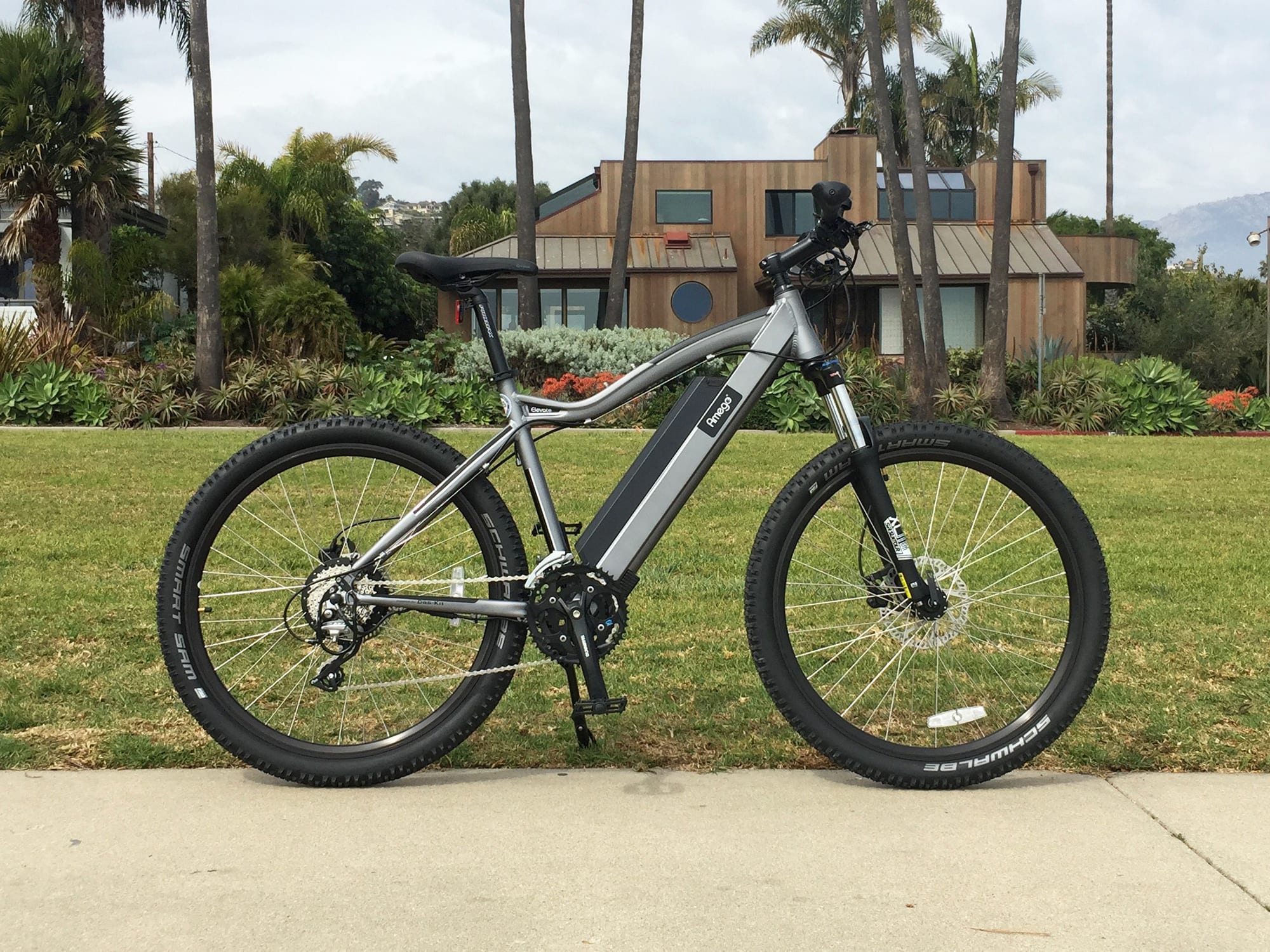
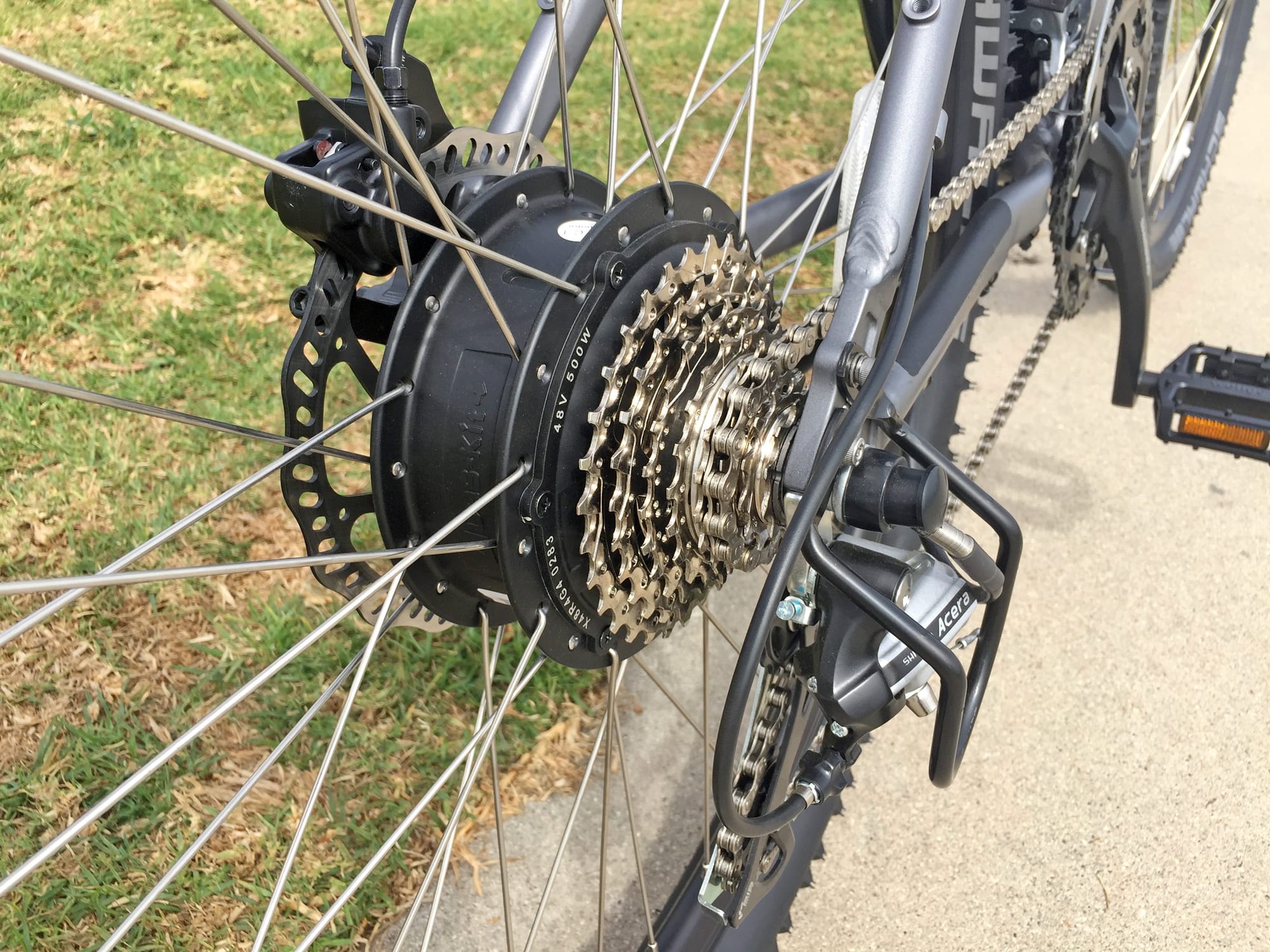
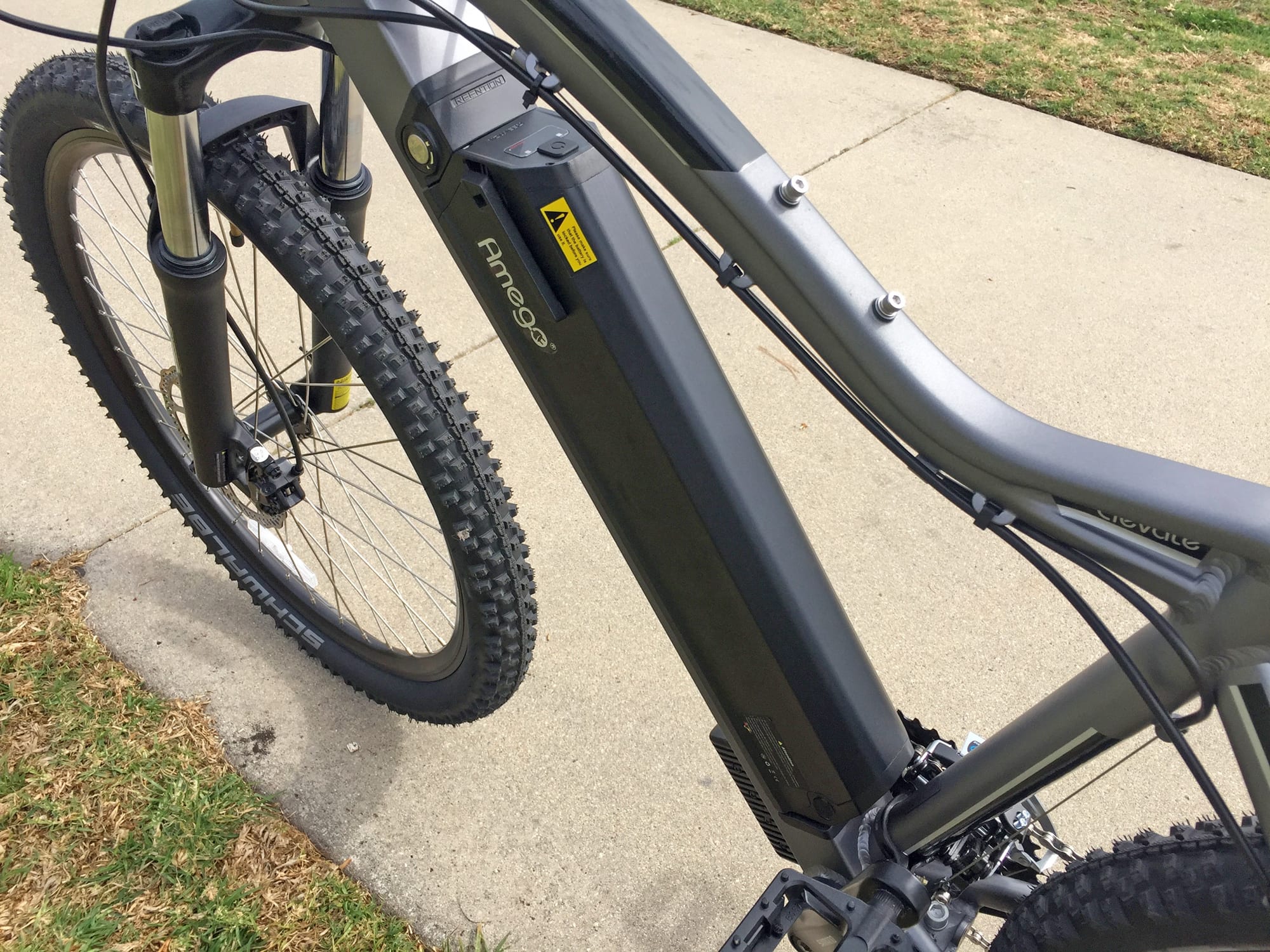
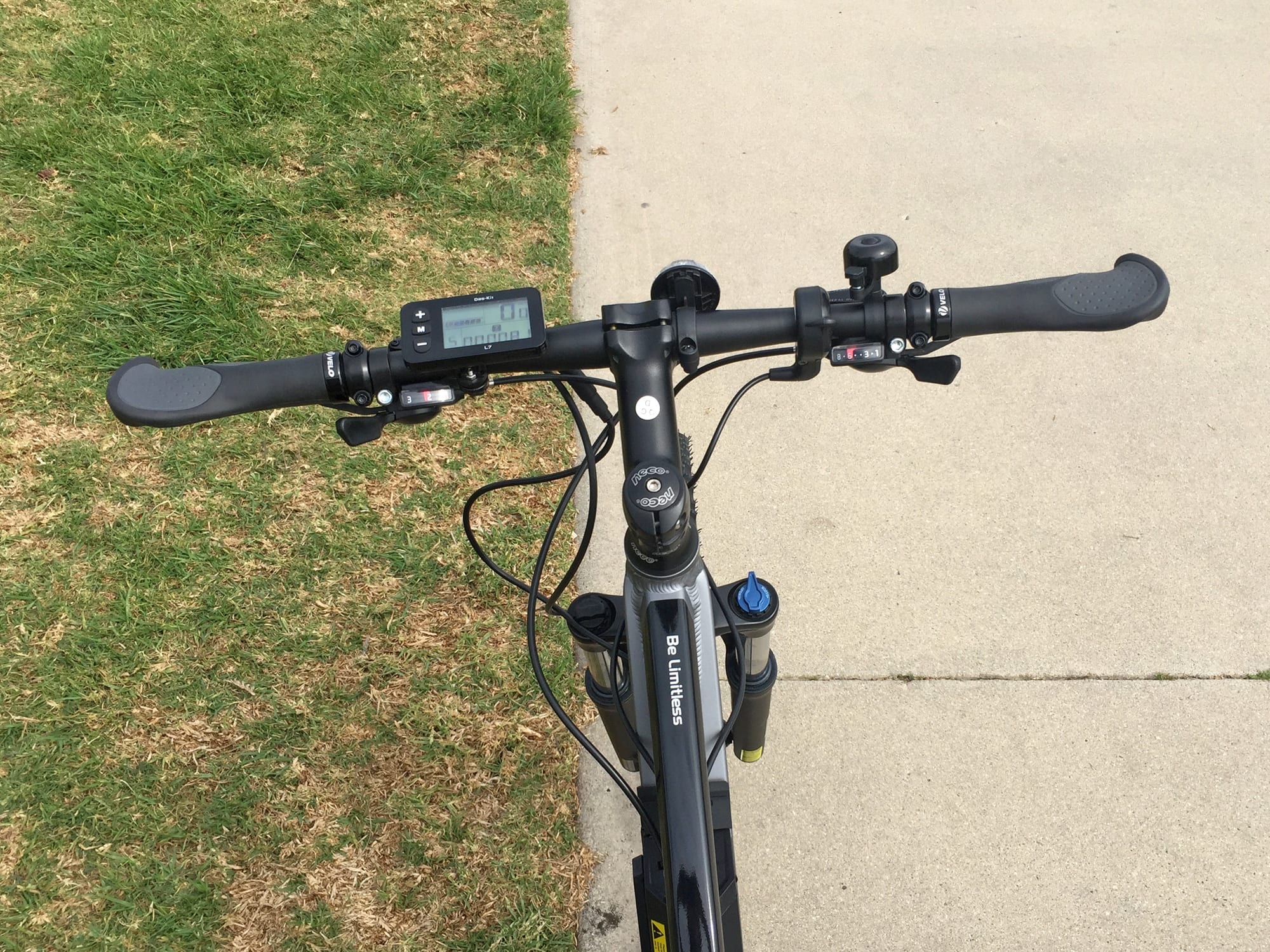
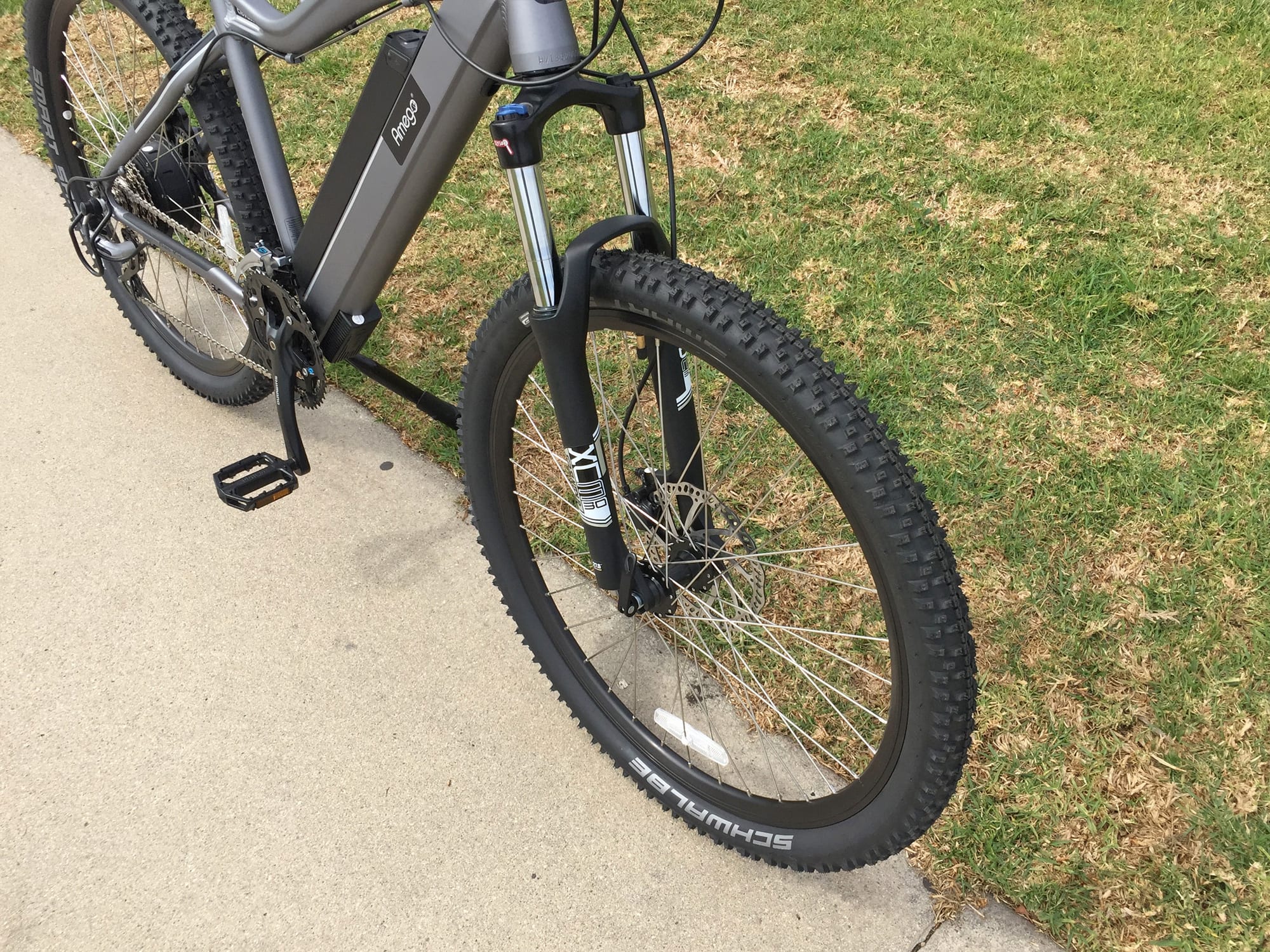

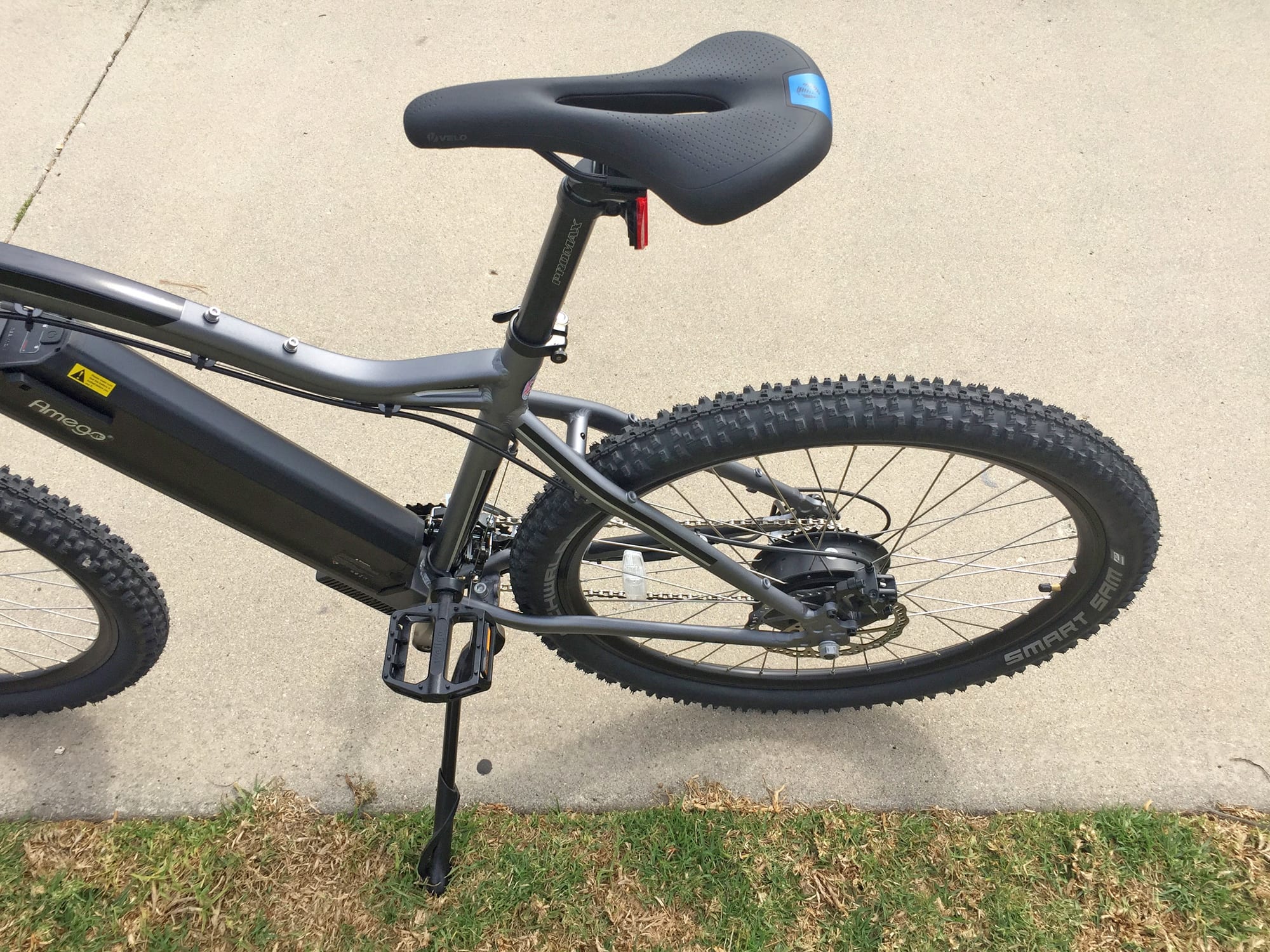
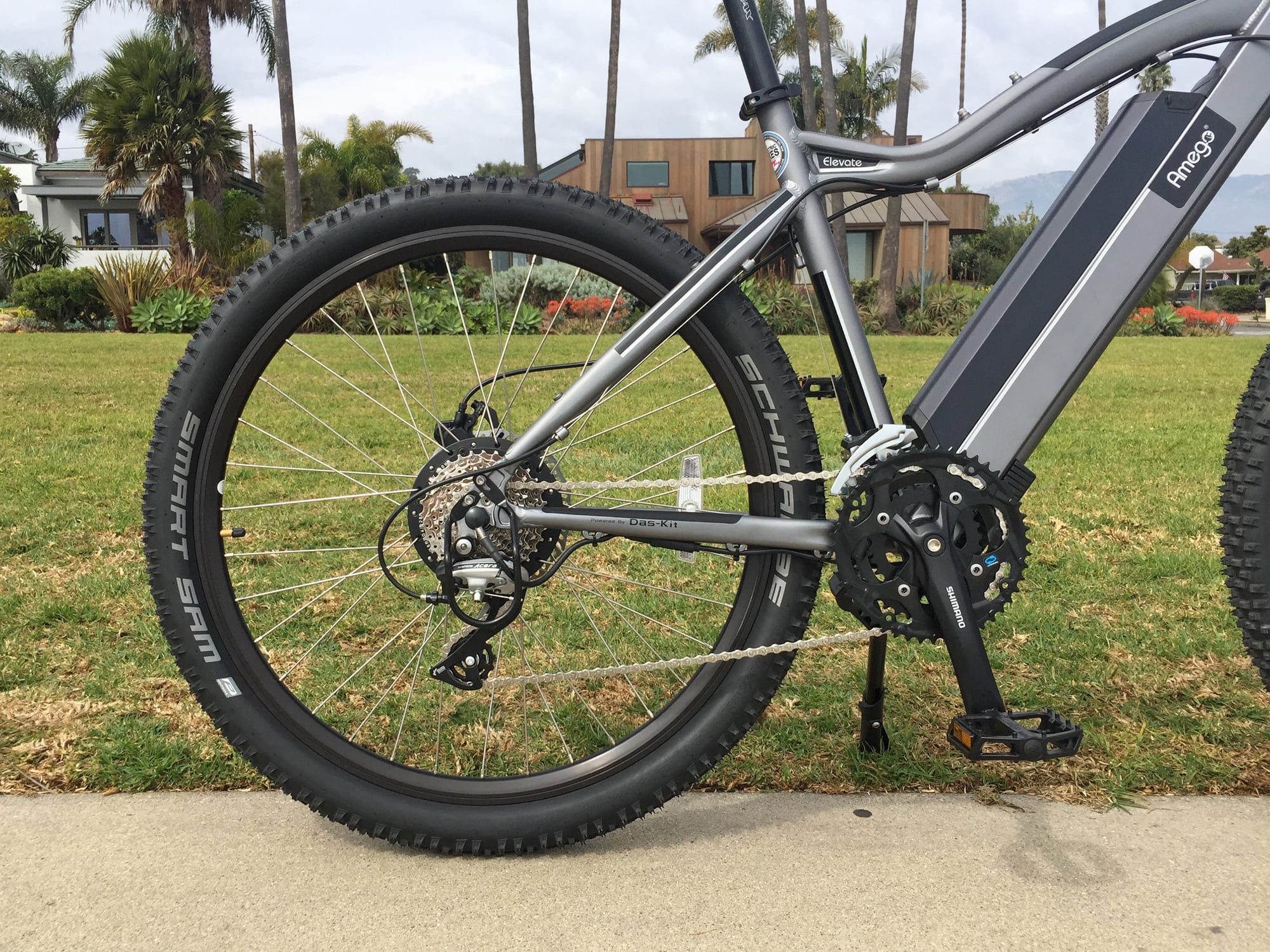
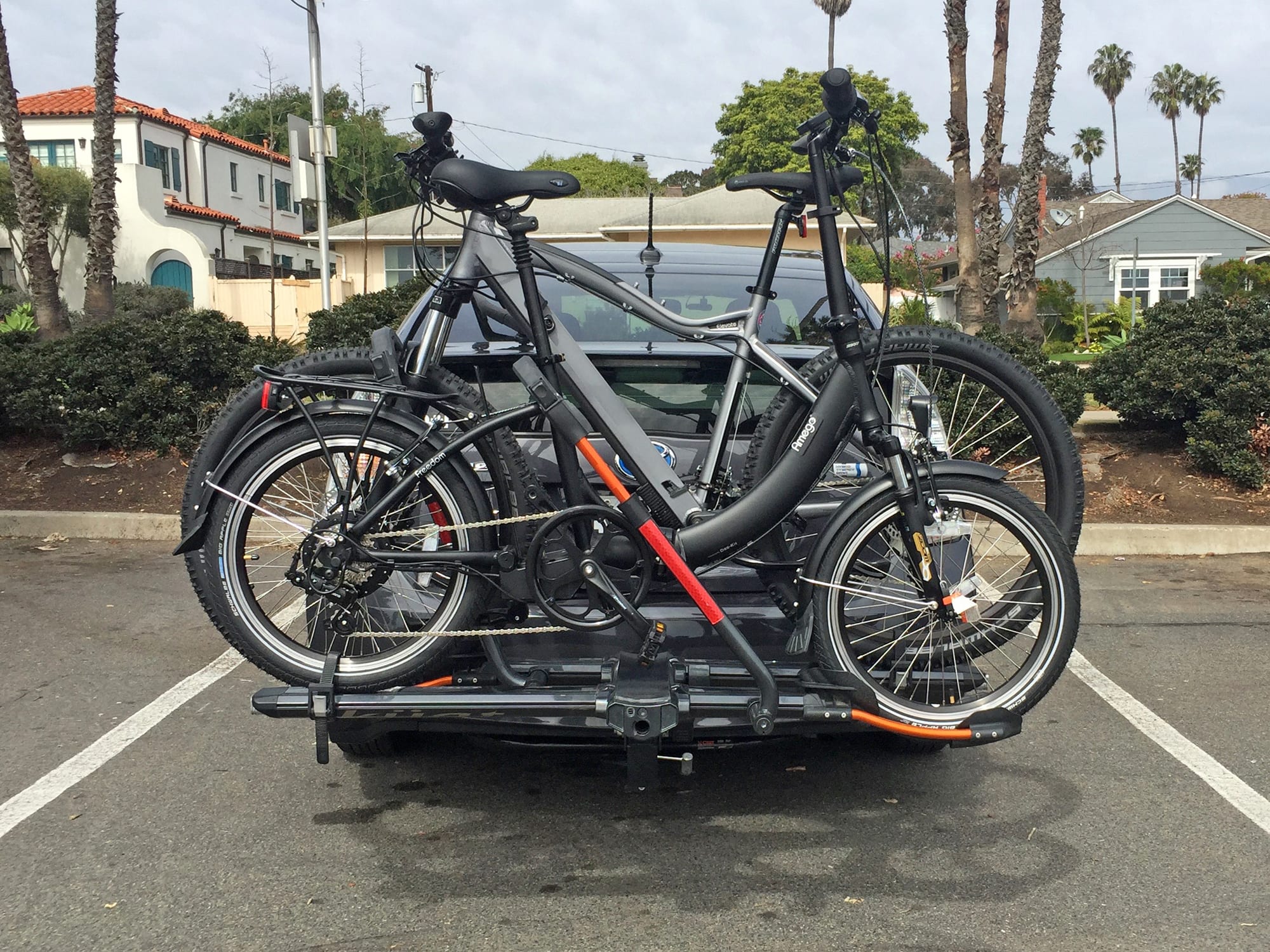
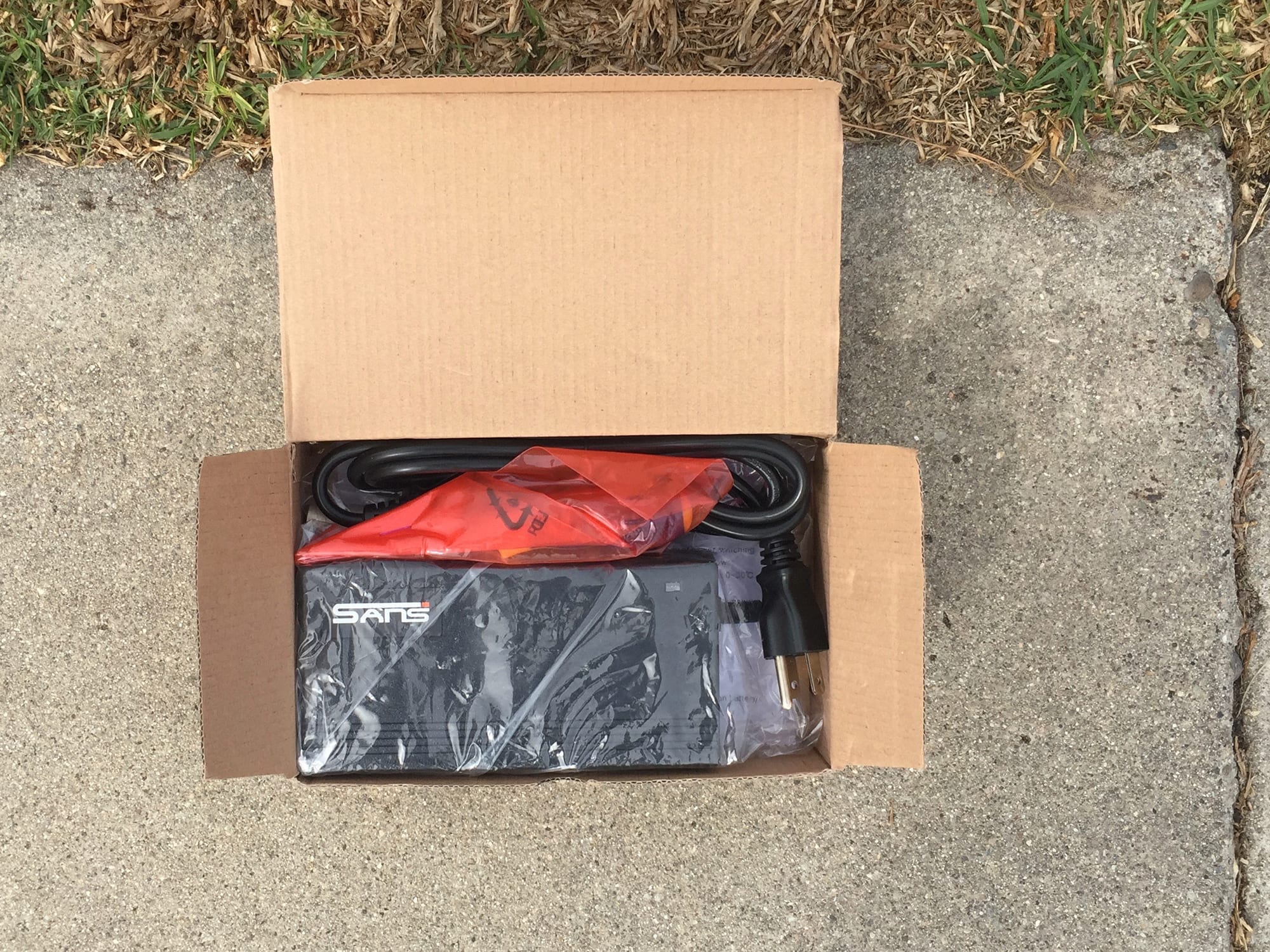


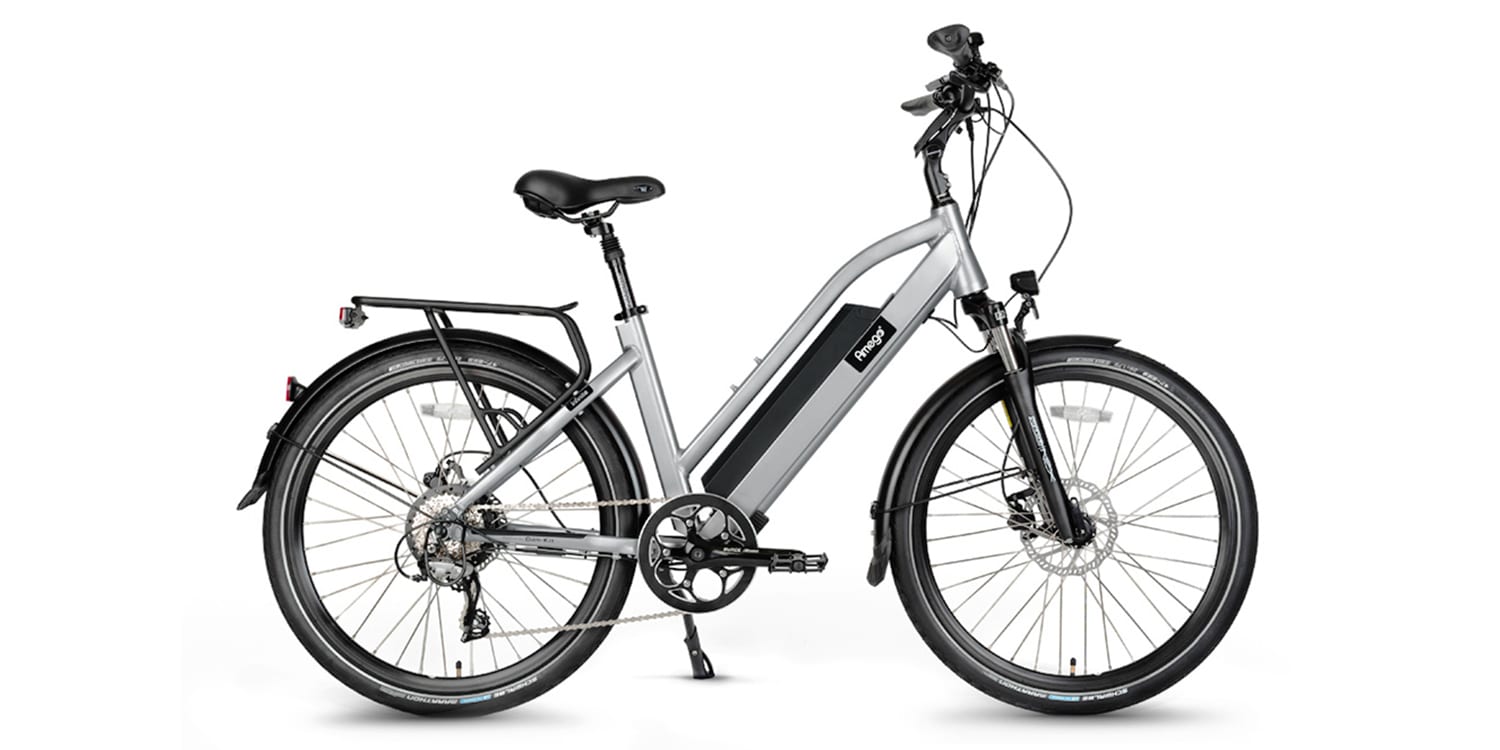
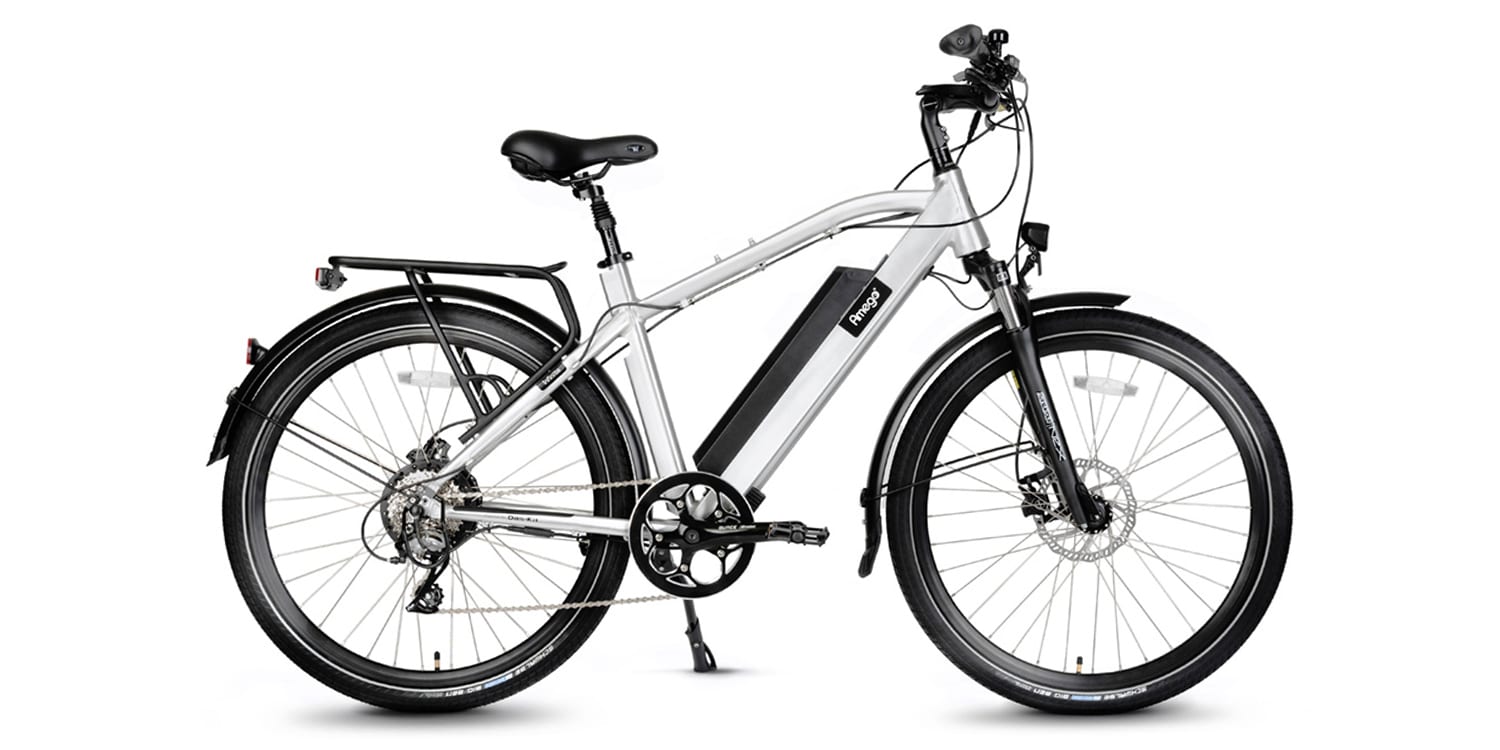
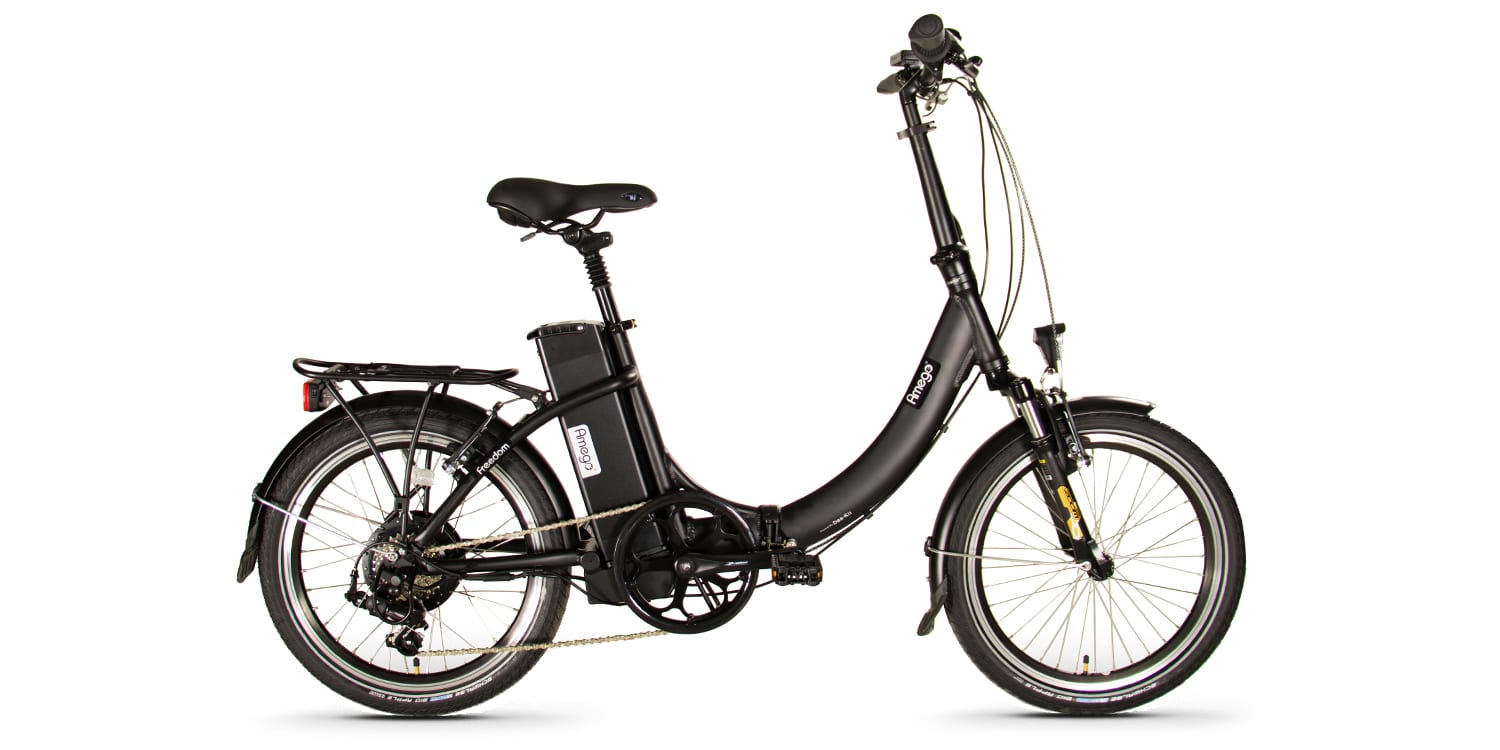
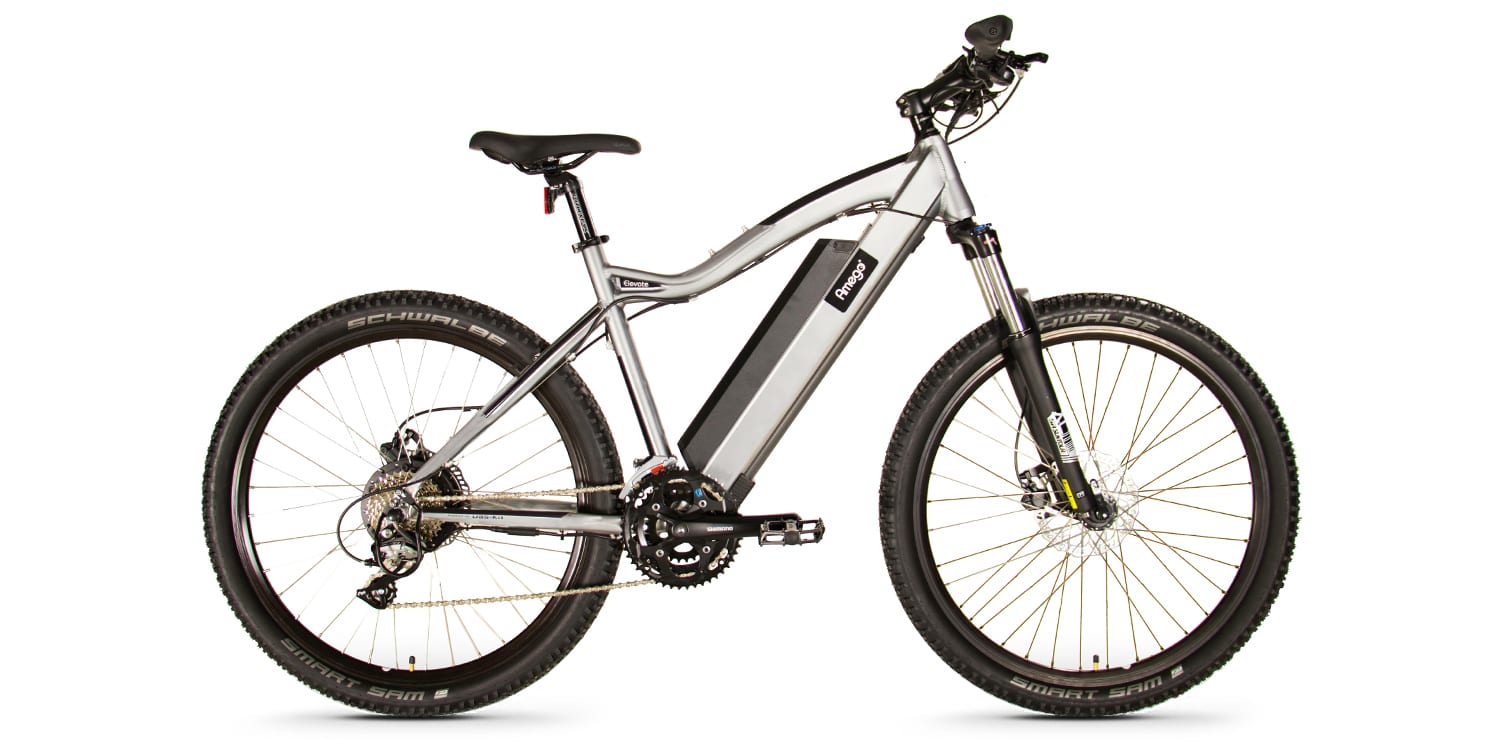

Ken says
The bikes in the value focused mid-tier ($1500-$2,500) don’t seem to be differentiating much on configuration or design. This bike is nice but is very very similar to the Magnum Peak which is similar to a Juiced Cycles Cross Current S. I’m not being critical but I think the industry would benefit from some risk taking at these price points. For example, they all seem to feel a front suspension is essential in that segment which is dubious considering that many buyers may never take them for any serious off-road riding. Gear hub motors provide good performance (high torque) but will suffer from lower reliability / higher service requirements because of internal plastic gearing. Not a big deal if buyers are only riding these bikes maybe 1,000 miles a year (probably the reality of the market as it takes a real commitment to commute regularly) but if someone is really considering one of these bikes as an alternative to a car for commuting this could be a very big deal. Why are there no CrMo frames still offered at these price points – maybe it can’t be hydro-formed into fancy tubes like Aluminum but it’s arguably a more reliable and comfortable frame material. Anyway, minor points as this is a nice bike for the price but just don’t want to see the whole segment become the same bike sourced and sold under 20 different brands.
While I understand it’s a higher price model, I think a bike like the Bulls Outlaw broke out of the cookie cutter mentality – didn’t try to pretend to be a traditional bike by hiding the battery, looked like a sport trail bike but has the high performance dual compound Moto X street optimized tires. Still has a geared hub motor but I can understand the desire to have that low speed torque to WOW people on test drives even though a direct drive hub motor may be a better fit on a bike like this (at higher speeds the performance advantage kind of swings towards the direct drive motor configuration).
court says
Excellent points and perspective Ken, it looks like Juiced does offer a model without a suspension fork for a bit less money called the CrossCurrent Air, but still uses an alloy frame. Another similar model that was launched recently, utilizing the same downtube battery design, is the Surface 604 Shred. I like this model because it offers some plus sized tires and upgraded hardware. It was neat to see Bulls experimenting with the Outlaw and Haibike launching the Urban Plus recently but I’m not sure that either sold especially well, the Haibike saw a big price cut presumably to liquidate inventory.
ken says
Hey Court, still a good review. :-)
You are most likely correct about the sales on the Bulls Outlaw and Haibike Urban Plus. Both very interesting bikes for various reasons. I liked the concept of the Bulls Outlaw because it made no attempt to hide it’s eBike pedigree. I couldn’t help but think the Outlaw was priced a bit high given the hub motor and battery which required less high level integration to the bike platform (kind of kit-like but a very cool kit). They emphasized that it was a comfortable bike but still looked like it has a somewhat more aggressive riding position (I always considered comfortable to be a bar height 2-4 inches above a fairly extended seat height – with power, why would you force someone to be in an aero riding posture as anyone can still tuck to achieve that when needed/desired?
Same comment applies on riding position on the Haibike Urban Plus. I really wanted to buy one of these but I expected Haibike to fix the bugs that were reported to plague the Cobi system (I can’t seem to even find a blue tooth mouse that stays connected to my PC sitting right next to it). I’ve always felt that rear hub motors were the best fast urban bike drive system configuration but this bike was/is impressive looking (albeit not really because they hid/integrated the battery so well). The TransX motor looks like a quality motor but it’s hard to find out anything about the internal configuration to get an idea on how much service it may require. I think the jury is still out on what the life cycle ownership costs of a mid-drive will be vs a gear hub motor vs a direct drive hub motor (most likely the direct drive will be lowest but is it significant to impact buying decisions?). While I prefer a bike with no active suspension for street riding, I’m wondering if the mindset that most riders have about the importance of a front fork impacted sales as well.
Anyway, just thinking out loud as I’m no expert on what is most desirable in this segment… I just have my own preferences that bias my opinion. Keep doing what your doing as you are gaining influence in an industry that is just getting it’s footing in the US, eventually more people will get out of cars and put more miles on eBikes as they are such a great human scale transportation solution.
Mike says
Ken – I’ve sold hundreds of hub drives, and not one has come back with a failure. Before you talk about ‘plastic’ gears, please explain the dynamics involved, and then tell us about the gears in a Bosch or Yamaha or Brose, and explain why you believe those might last longer or how it is they might be more reliable? By the way, I have opened up and serviced all of the above myself and many hub drives.
I’m a degreed mechanical engineer, and have rebuilt cars from the ground up, starting back in the mid 70’s. Please be thoughtful when you make these sorts of attacks on hub drives. Please explain your specific experiences and provide a lot more context. Please. It’s otherwise a dis-service to the public reading this, and I’m frankly surprised Court allowed it to be posted.
court says
Thanks Mike! I try to leave as many comments posted as possible and do my best to respond even-handedly… but also create a space where users like yourself can chime in. I am not a degreed mechanical engineer, and even though I go on camera here, I always limit how commanding and “certain” my comments come across because I do not know everything and have not owned these products for long enough to have stronger opinions in most cases. So thank you for chiming in :)
ken says
Hi Mike,
I think you mis-read my comments. I’m a believer in hub motors. The simplicity of a gear less hub motor seems the ideal design for reliable human-scale transportation and when traveling over say 20kph they essentially are as efficient as mid-drives. The fact that the torque is delivered directly to the rear wheel is also a significant factor when at higher speeds the gear ratio of a chain drive is working against the mid-drive.
I do respect that mid-drives are very effective drive systems for off-road / trail / mountain bikes that typically remain as speeds under 20kph.
Mike says
Yep. Pretty much a Carbon copy of the Magnum Peak, and in fact using their same equipment such as the Das-Kit branded product, all the way down to the same 6 levels of assist, 24 speeds, same 13 AH capacity battery and on and on. Paint color is different though ;)
Gotta love that 80 NM of torque, that so many people act like just comes in a mid drive, and whats great about getting this in a hub drive, is there are no losses through the drive train like a mid drive would lose, and you wont be shredding chains, or sprockets or cassettes. Plus, you get a throttle like you wont on most mid drives. But tack on another $1000, to get this same spec’d ebike in another brand of mid drive bike, and its yours for the privilege of saying hey “but I gots me a mid drive.”
The market definitely needs way more options under that $2,000 price point, and quality hub drive ebikes with lots of torque like this certainly can be done quite cost effectively. The beauty of that hub drive, is there are millions of them sold per year world wide, and even if it fails entirely (which is actually rare for hub drives) it can be replaced for about 25% of the cost of a mid drive. At some point the internal gears might wear, but those too are easily replaced.
Kudos to Amego, even if its the Canadian version of the Magnum Peak. (just like their Infinite Model looks (is) just like the Magnum Metro).
court says
Yeah, there’s a lot of overlap with this frame, motor, display and I think it offers great value. Virginia has chosen some very unique colors, cool accessories, and she sells in person and online so I feel like she may have been working out more of the kinks. At the end of the day, it’s just nice to have choice, I like Amego, Magnum, Juiced Bikes, Surface 604, and others who are working with Leisger (one of the primary manufacturers who supply) to make ebikes :)
Rich says
Having bottle cage mounts in the “nutcracker” position for a dismount isn’t an advantage in my opinion.
court says
Yeah, it’s not optimal… you can remove the bolts and the top tube becomes fairly smooth and low again. I could see it as a decent place for a slim folding lock. Some similar ebike have positioned the bottle cage bosses below the downtube like this, but that can require more reaching.
Laura says
Hello Court, I am looking to buy my first ebike. I am looking at the Moscow Plus and this one. I noticed you listed the Moscow as urban, trail, mountain and this one only as urban. Is there a reason? The specs seem the same. I live in the mountains of California and I am not sure we have even one flat road and a lot of dirt roads. I need one that can do town and forest service type roads.
Thanks
Laura
Court says
Hi Laura! Great catch… Our system is a bit redundant in that it has categories and then another section that is like categories that describe different ways a bike can be used. This is on my long list of things to improve with the site because it’s easy to accidentally skip one of the sections when editing. That’s what happened in this case. Yes, the Amego Elevate is well suited to light trails and mountain riding. I categorized it as cross country, hardtail, electric mountain bike and I feel like it would be a great fit for you. Amego does a great job, NCM seems decent, but doesn’t have as many dealers in the states (from what I’ve seen) and there are other very similar products like the Surface 604 Shred that I reviewed a couple of days ago. I feel like the Amego Elevate or the Shred would be great choices because they have been around in Canada and the US for a while and have a good support team behind them :)